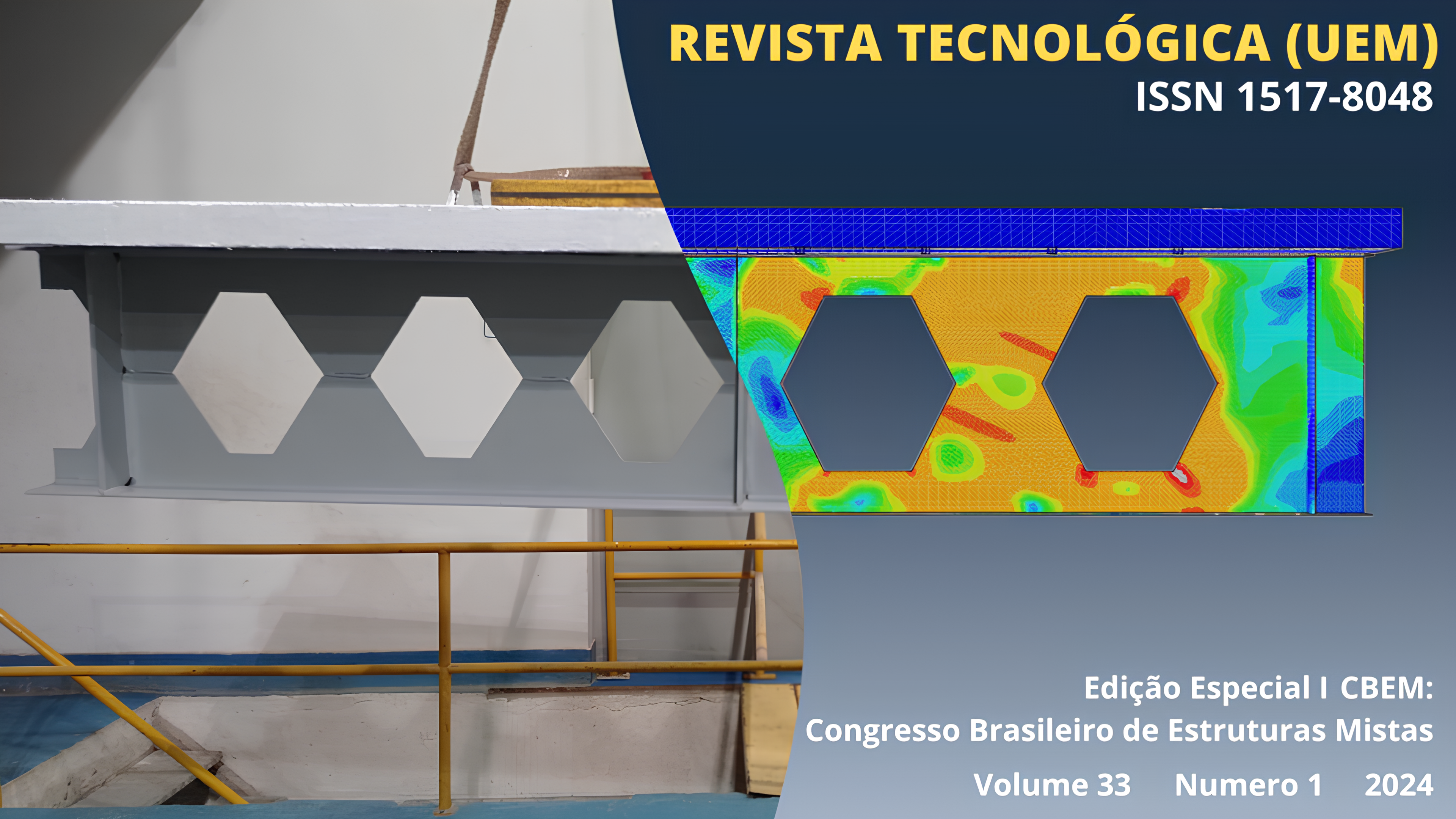MÉTODOS DE PROJETO PARA PILARES MISTOS CURTOS CIRCULARES PREENCHIDOS COM CONCRETO RECICLADO SUJEITOS A CARGA AXIAL CENTRADA
Resumo
O confinamento do concreto reciclado ou Recycled Aggregate Concrete (RAC) tornou-se uma alternativa interessante para uso em estruturas devido à sua maior deformabilidade e menor resistência. Os pilares mistos preenchidos com concreto reciclado ou Recycled Aggregate Concrete-Filled Steel Tube (RACFST) são uma opção econômica em comparação ao Concrete-Filled Steel Tube (CFST), além de diminuir o impacto ambiental e o consumo de recursos naturais. No entanto, as recomendações existentes são para pilares CFST, e atualmente há apenas uma norma de projeto específica para pilares RACFST. O objetivo deste trabalho é identificar a aplicabilidade de normas e métodos da literatura em projetos de pilares RACFST. Sete normas para CFST, uma para RACFST e quatro métodos da literatura para RACFST foram testados em 97 resultados experimentais de pilares curtos RACFST. Todas as normas se mostraram eficientes no cálculo da capacidade resistente dos pilares RACFST, sendo a resistência à compressão do RAC o parâmetro principal que difere os métodos. O efeito de confinamento é considerado de maneiras distintas, o que também afeta a capacidade resistente dos pilares RACFST.
Downloads
Referências
AMERICAN INSTITUTE OF STEEL CONSTRUCTION. ANSI/AISC 360: Specification for Structural Steel Buildings. Chicago, 2016.
ASSOCIAÇÃO BRASILEIRA DE NORMAS TÉCNICAS. NBR 8800: Projeto de estruturas de aço e de estruturas mistas de aço e concreto de edifícios. Rio de Janeiro, 2008.
AZEVEDO, V. S. et al. Experimental investigation on recycled aggregate concrete filled steel tubular stub columns under axial compression. Journal of Constructional Steel Research, v. 187, p. 106930, 2021. https://doi.org/10.1016/j.jcsr.2021.106930
CANADIAN STANDARDS ASSOSIATION. CAN/CSA S16-09: Design of steel structures. Ontario, 2009.
CHEN, K. et al. Intelligent design of limit states for recycled aggregate concrete filled steel tubular columns. Structures, v. 58, n. October, p. 105338, 2023a. https://doi.org/10.1016/j.istruc.2023.105338
CHEN, L. et al. Axial compressive strength predictive models for recycled aggregate concrete filled circular steel tube columns using ANN, GEP, and MLR. Journal of Building Engineering, v. 77, p. 107439, 2023b. https://doi.org/10.1016/j.jobe.2023.107439
CHEN, Z. et al. Performance and calculations of recycled aggregate concrete-filled steel tubular (RACFST) short columns under axial compression. International Journal of Steel Structures, v. 14, n. 1, p. 31–42, 2014. https://doi.org/10.1007/s13296-014-1005-5
DONG, J. F.; WANG, Q. Y.; GUAN, Z. W. Material and structural response of steel tube confined recycled earthquake waste concrete subjected to axial compression. Magazine of Concrete Research, v. 68, n. 6, p. 271–282, 2016. https://doi.org/10.1680/jmacr.14.00357
EUROPEAN COMMITTEE FOR STANDARDIZATION. EUROCODE 2: Design of concrete structures - Part 1-1: General rules and rules for buildings. Brussels, 2004.
EUROPEAN COMMITTEE FOR STANDARDIZATION. EUROCODE 4: Design of composite steel and concrete structures – Part 1-1: General rules and rules for buildings. Brussels, 2004.
GB50936. GB 50936-2014: Technical code for concrete filed steel tubular structures. Beijing, 2014 (em chines).
HAN, L. H.; XU, C. Y.; HOU, C. Axial compression and bond behaviour of recycled aggregate concrete-filled stainless steel tubular stub columns. Engineering Structures, v. 262, n. May, p. 114306, 2022. https://doi.org/10.1016/j.engstruct.2022.114306
LYU, W. Q.; HAN, L. H.; HOU, C. Axial compressive behaviour and design calculations on recycled aggregate concrete-filled steel tubular (RAC-FST) stub columns. Engineering Structures, v. 241, n. May, p. 112452, 2021. https://doi.org/10.1016/j.engstruct.2021.112452
SHANMUGAM, N. E.; LAKSHMI, B. State of the art report on steel-concrete composite columns. Journal of Constructional Steel Research, v. 57, n. 10, p. 1041–1080, 2001. https://doi.org/10.1016/S0143-974X(01)00021-9
T/CECS 625. TCECS 625-2019: Technical specification for recycled aggregate concrete-filled steel tubular structures. Beijing, 2019 (em chines).
TAM, V. W. Y.; WANG, Z. BIN; TAO, Z. Behaviour of recycled aggregate concrete filled stainless steel stub columns. Materials and Structures/Materiaux et Constructions, v. 47, n. 1–2, p. 293–310, 2014. https://doi.org/10.1617/s11527-013-0061-1
WANG, E. et al. Confinement Effect and Efficiency of Concentrically Loaded RACFCST Stub Columns. Materials, v. 15, n. 1, p. 18, 2022. https://doi.org/10.3390/ma15010154
WANG, Y.; CHEN, J.; GENG, Y. Testing and analysis of axially loaded normal-strength recycled aggregate concrete filled steel tubular stub columns. Engineering Structures, v. 86, p. 192–212, 2015. https://doi.org/10.1016/j.engstruct.2015.01.007
XIAO, J. et al. Mechanical properties of confined recycled aggregate concrete under axial compression. Construction and Building Materials, v. 26, n. 1, p. 591–603, 2012. https://doi.org/10.1016/j.conbuildmat.2011.06.062
YANG, D.; LIU, F.; WANG, Y. Axial compression behaviour of rectangular recycled aggregate concrete-filled steel tubular stub columns. Journal of Constructional Steel Research, v. 201, p. 107687, 2023. https://doi.org/10.1016/j.jcsr.2022.107687
YANG, Y. F.; HAN, L.-H.; MAN, L. H. Compressive and flexural behaviour of recycled aggregate concrete filled steel tubes (RACFST) under short-term loadings. Steel and Composite Structures, v. 6, n. 3, p. 257–284, 2006.
ZHANG, W. H. et al. Axial-load response of CFST stub columns with external stainless steel and recycled aggregate concrete: Testing, mechanism analysis and design. Engineering Structures, v. 256, p. 113968, 2022. https://doi.org/10.1016/j.engstruct.2022.113968
ZHAO, H. et al. Performance of recycled aggregate concrete-filled high-strength steel tubes under axial compression , tension and torsion. Thin-Walled Structures, v. 184, p. 110478, 2023. https://doi.org/10.1016/j.tws.2022.110478
Os autores podem manter os direitos autorais pelo seu trabalho, mas repassam direitos de primeira publicação à revista. A revista poderá usar o trabalho para fins não-comerciais, incluindo direito de enviar o trabalho em bases de dados de Acesso Livre.











